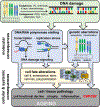The central role of DNA damage in the ageing process
- PMID: 33911272
- PMCID: PMC9844150
- DOI: 10.1038/s41586-021-03307-7
The central role of DNA damage in the ageing process
Abstract
Ageing is a complex, multifaceted process leading to widespread functional decline that affects every organ and tissue, but it remains unknown whether ageing has a unifying causal mechanism or is grounded in multiple sources. Phenotypically, the ageing process is associated with a wide variety of features at the molecular, cellular and physiological level-for example, genomic and epigenomic alterations, loss of proteostasis, declining overall cellular and subcellular function and deregulation of signalling systems. However, the relative importance, mechanistic interrelationships and hierarchical order of these features of ageing have not been clarified. Here we synthesize accumulating evidence that DNA damage affects most, if not all, aspects of the ageing phenotype, making it a potentially unifying cause of ageing. Targeting DNA damage and its mechanistic links with the ageing phenotype will provide a logical rationale for developing unified interventions to counteract age-related dysfunction and disease.
Conflict of interest statement
Competing interests:
Jan Vijg is co-founder of SingulOmics Corp., USA
Figures



References
-
- Schumacher B The Mystery of Human Aging: Surprising Insights from a Science That’s Still Young. (Algora Publishing, 2017).
-
- Williams GC Pleiotropy, Natural Selection, and the Evolution of Senescence. Evolution (N. Y). 11, 398–411 (1957).
-
- Lindahl T Instability and decay of the primary structure of DNA. Nature 362, 709–715 (1993). - PubMed
Publication types
MeSH terms
Grants and funding
LinkOut - more resources
Full Text Sources
Other Literature Sources
Medical

